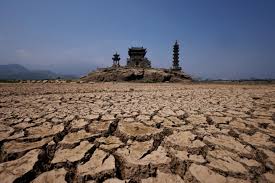Temperatures are soaring to unprecedented levels in parts of north and central China this week. Simultaneously, the east of the country is grappling with a severe drought that threatens vital crops. As nations across Asia brace themselves for another summer of extreme weather, the impact on daily life and agriculture is profound. The state weather forecaster has predicted temperatures as high as 42 degrees Celsius (107.6°F) in northern Hebei province by Wednesday.
The Scorching Heatwave: An Overview
Unprecedented Temperatures
China is currently enduring a severe heatwave, with temperatures in some regions set to break historical records. Northern Hebei province is expected to experience highs of 42 degrees Celsius, making this one of the hottest periods in recent history.
Historical Comparisons
To put this in perspective, these temperatures are significantly higher than the seasonal averages, highlighting the severity of the current heatwave. Previous records show that while high temperatures are not uncommon, the sustained intensity of this heat is unusual.
The Impact on Daily Life
Health Risks
High temperatures pose serious health risks, including heat exhaustion and heatstroke. Vulnerable populations, such as the elderly and young children, are particularly at risk. Public health advisories are in place, urging residents to stay hydrated and avoid prolonged exposure to the sun.
Power Consumption
With the mercury rising, the demand for electricity is also surging as air conditioning units run overtime. This increased consumption puts a strain on the power grid, potentially leading to outages and the need for energy conservation measures.
Agricultural Concerns Amid Drought
Drought in the East
While the north and central regions are sweltering, eastern China faces a different but equally severe challenge: drought. The lack of rainfall has led to water shortages, severely impacting agricultural productivity.
Threat to Crops
The drought threatens key crops, including rice and wheat, which are essential to both the local economy and food security. Farmers are struggling to irrigate their fields, and there are growing concerns about reduced yields and the subsequent impact on food supply.
Extreme Weather Across Asia
A Regional Phenomenon
China is not alone in facing extreme weather this summer. Countries across Asia are experiencing similar conditions, with record temperatures and unusual weather patterns becoming increasingly common.
Climate Change Connection
Scientists attribute these extreme weather events to climate change, noting that rising global temperatures are making heatwaves and droughts more frequent and severe. This trend poses a long-term challenge for the region, necessitating urgent climate action.
Mitigation and Adaptation Strategies
Government Initiatives
In response to these challenges, the Chinese government is implementing various measures to mitigate the impact of extreme weather. This includes improving water management systems, promoting energy efficiency, and investing in climate-resilient infrastructure.
Community Efforts
Local communities are also playing a crucial role in adapting to these conditions. From setting up cooling centers to organizing water distribution, grassroots efforts are vital in helping residents cope with the heat and drought.
Looking Ahead
Weather Forecast
The forecast suggests that the heatwave will persist for several days, with little relief in sight. Residents are advised to take necessary precautions and stay informed about weather updates.
Long-Term Solutions
Addressing the root causes of these extreme weather events requires a global effort. Reducing greenhouse gas emissions, enhancing climate resilience, and adopting sustainable practices are essential steps toward a more stable climate future.
As China faces a scorching heatwave in the north and central regions and a severe drought in the east, the implications for health, agriculture, and daily life are significant. This situation underscores the urgent need for climate action and adaptation strategies to protect communities and ensure sustainable development in the face of growing climate challenges.




